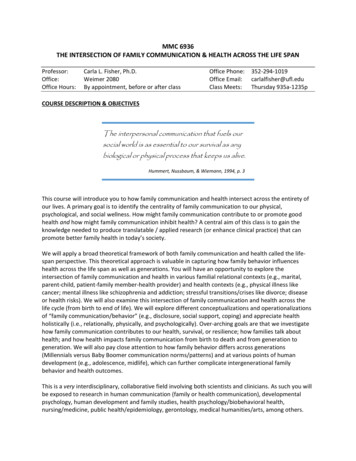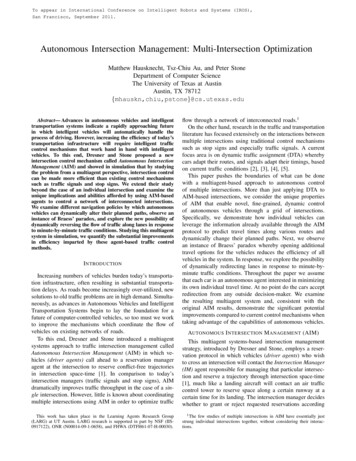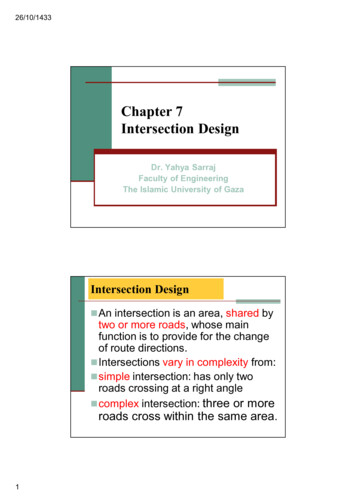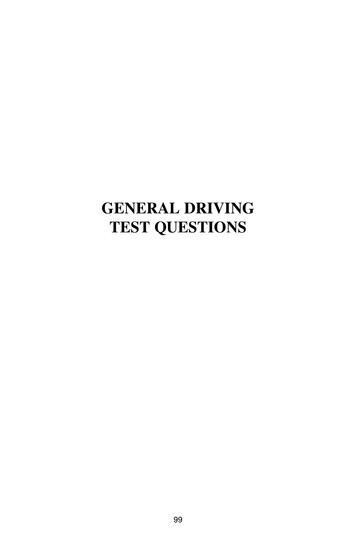
Transcription
MMC 6936THE INTERSECTION OF FAMILY COMMUNICATION & HEALTH ACROSS THE LIFE SPANProfessor:Office:Office Hours:Carla L. Fisher, Ph.D.Weimer 2080By appointment, before or after classOffice Phone:Office Email:Class Meets:352-294-1019carlalfisher@ufl.eduThursday 935a-1235pCOURSE DESCRIPTION & OBJECTIVESThe interpersonal communication that fuels oursocial world is as essential to our survival as anybiological or physical process that keeps us alive.Hummert, Nussbaum, & Wiemann, 1994, p. 3This course will introduce you to how family communication and health intersect across the entirety ofour lives. A primary goal is to identify the centrality of family communication to our physical,psychological, and social wellness. How might family communication contribute to or promote goodhealth and how might family communication inhibit health? A central aim of this class is to gain theknowledge needed to produce translatable / applied research (or enhance clinical practice) that canpromote better family health in today’s society.We will apply a broad theoretical framework of both family communication and health called the lifespan perspective. This theoretical approach is valuable in capturing how family behavior influenceshealth across the life span as well as generations. You will have an opportunity to explore theintersection of family communication and health in various familial relational contexts (e.g., marital,parent-child, patient-family member-health provider) and health contexts (e.g., physical illness likecancer; mental illness like schizophrenia and addiction; stressful transitions/crises like divorce; diseaseor health risks). We will also examine this intersection of family communication and health across thelife cycle (from birth to end of life). We will explore different conceptualizations and operationalizationsof “family communication/behavior” (e.g., disclosure, social support, coping) and appreciate healthholistically (i.e., relationally, physically, and psychologically). Over-arching goals are that we investigatehow family communication contributes to our health, survival, or resilience; how families talk abouthealth; and how health impacts family communication from birth to death and from generation togeneration. We will also pay close attention to how family behavior differs across generations(Millennials versus Baby Boomer communication norms/patterns) and at various points of humandevelopment (e.g., adolescence, midlife), which can further complicate intergenerational familybehavior and health outcomes.This is a very interdisciplinary, collaborative field involving both scientists and clinicians. As such you willbe exposed to research in human communication (family or health communication), developmentalpsychology, human development and family studies, health psychology/biobehavioral health,nursing/medicine, public health/epidemiology, gerontology, medical humanities/arts, among others.
You will also be exposed to interventional and applied/translational research. Our exploration ofresearch will be inclusive and include critical, interpretive, and empirical forms of research as well astranslational tools like documentaries. We will also critically read two books which represent researchexploring the intersection of family communication health, research applying a life-span perspective,and producing knowledge critical to understanding the centrality of family behavior to health.To accomplish our goals, the course is divided into 4 sections.I.UNDERSTANDING THE FOUNDATION – THE GROUNDWORKa. We will begin by laying the groundwork by connecting three broad areas of research: 1)family communication/behavior; 2) health; and 3) life-span theory. These initial readingswill help you understand the life-span theoretical perspective of behavior and health.We can use this perspective to better comprehend how family communication andhealth intersect across the entirety of our lives. We will also look at specific theoriesused across disciplines and in health practice. Once this groundwork is laid, we willspend the remaining 3 phases of the class applying the life-span perspective tounderstand how family behavior and health are connected across life. This applicationwill be done in the following 3 ways:II. FAMILY COMMUNICATION ACROSS THE SEASONS OF LIFE: HUMAN DEVELOPMENT &SUCCESSFUL AGINGa. First, we will explore family interaction and wellness across the life span by focusing onperiods of human development or across the “seasons of life” (e.g., adolescence, youngadulthood, midlife, later life, end of life). How does family interaction affect ourdevelopment and vice versa? In doing so we will explore the concept of “successfulaging” and how kin interaction affects healthy aging as well as end of life.III. ADAPTING TO CHANGE: FAMILY COPING & STRESSFUL TRANSITIONS ACROSS THE LIFE SPANa. Second, we will examine how family communication affects our ability to cope with nonnormative stressful changes/crises/transitions (e.g., a life-threatening health diagnosis)as well as those challenges that are more normative (e.g., having a baby). How doesfamily communication affect our ability to adapt during times of stress, how is ourcommunication tied to health outcomes while coping, and how do familycommunication patterns impact resilience? In other words, we will examine theadaptive or maladaptive functioning of our kin behavior during turning points /transitions.IV. LONGITUDINAL PERSPECTIVES: FAMILY COMMUNICATION & HEALTH OUTCOMESa. Third, we will examine the potential longitudinal implications of family communicationon the development of health outcomes (e.g., mental illness, disease, substance abuse,violent behavior, suicidality). How do family communication patterns contribute to thedevelopment of disease or disorders (both physical and mental)? How might familycommunication reduce our disease risk? In essence, we will investigate how certainfamily communication patterns contribute to healthy and unhealthy outcomes and howthose patterns can be transmitted across generations.
MATERIALSREQUIRED TEXTSPecchioni, L. L., Wright, K., & Nussbaum, J. F. (2005). Life-span communication. Mahwah, NJ: Erlbaum.Segrin, C., & Flora, J. (2011). Family communication, 2nd edition. New York: RoutledgeFisher, C. L. (2014). Coping together, side by side: Enriching mother-daughter communication across thebreast cancer journey. New York: Hampton Press.Fadiman, A. (1998). The spirit catches you and you fall down: A Hmong child, her American doctors, anda collision of two cultures. New York: Farrar, Straus & Giroux.ADDITIONAL REQUIRED MATERIALS:1) Articles posted on Canvas2) APA style manualRECOMMENDED TEXTS/RESOURCES *please see me about specific contexts!Bengtson, V. L., Putney, N., & Harris, J. (2013). Families and faith: How religion is passed down acrossgenerations. New York, NY.Bengtson, V. L., & Settersten Jr, R. (Eds.). (2016). Handbook of theories of aging. Spring.Braithwaite, D. O., & Baxter, L. A. (Eds.). (2006). Engaging theories in family communication: Multipleperspectives. Thousand Oaks, CA: Sage.Catherall, D. R. (Eds.). (2004). Handbook of stress, trauma, and the family. Sussex: Brunner-Routledge.Daly, K. J. (2007). Qualitative methods for family studies & human development. Thousand Oaks, CA:Sage.Falcov, C. J. (Ed.). (1988). Family transitions: Continuity & change over the life cycle. New York: Guilford.Gaff, C. L., & Bylund, C. L. (Eds.). (2010). Family communication about genetics: Theory and practice.Oxford: Oxford Press.Greenstein, M., & Holland, J. (2015). Lighter as we go: Virtues, character strengths, and aging. OxfordUniversity Press, USA.Harter, L. M., P. M. Japp, & C. S. Beck (Eds.), Narratives, health, and healing: Communication theory,research and practice. Mahwah, NJ: Erlbaum.Holland, J. C., & Zittoun, R. (Eds.). (2012). Psychosocial aspects of oncology. Springer Science & BusinessMedia.Maguire, Katheryn C. (2012). Stress and coping in families. Cambridge: Polity.McDaniel, S. H., Hepworth, J., & Doherty, W. J. (1991). Medical family therapy: A biopsychosocialapproach to families with health problems. New York: Basic Books.McKenry, P.C., & Price, P.C. (Eds.). (2005). Families & change: Coping with stressful events andtransitions. Thousand Oaks, CA: Sage.Miller-Day, M. (Ed.). (2010). Family communication, connections, and health transitions: Going throughthis together. New York: Peter Lang.Nussbaum, J. F. (Eds.). (2014). Handbook of life-span communication. New York: Peter Lang.Rolland, J. S. (1994). Families, illness, & disability: An integrative treatment model. New York: BasicBooks.Schmaling, K. B., & Goldman Sher, T. (Eds.). (2000). The psychobiology of couples and illness. WashingtonDC: American Psychological Association.Smith, A.M. (2012). Tracing family lines: The impact of genealogy research on family communication.Lexington BooksTurk, D. C., & Kerns, R. D. (Eds.). (1985). Health, illness, and families: A life-span perspective. New York:Wiley.Turner, L. H., & West, R. (Eds.) (2006). The family communication sourcebook. Thousand Oaks, CA: Sage.
Vangelisti, A. L. (Ed.). (2004). Handbook of family communication. Mahwah, NJ: Erlbaum.Walsh, F. (2006). Strengthening family resilience, 2nd edition. New York: Guilford.Whitman, T. L., Merluzzi, T. V., & White, R. D. (Eds.). (1999). Life-span perspectives on health and illness.Mahwah, NJ: Lawrence Erlbaum.GRADINGYour grade for the course is based on the following point scale. I do not curve or offer extra credit.In-Class Participation50A 450-500Discussion Board Responses (10 @ 10 points ea) 100B 400-449Discussion Facilitation/Outline (2 @ 25 points ea) 50C 350-399Paper Proposal100D 296-349Final Paper200F 295 or lessTotal Possible Points500COURSE REQUIREMENTS1. In-Class Participation:Punctuality and attendance are expected. This is a graduate-level seminar. As such, there will beminimal lecturing. At times I will briefly lecture in class to orient you to the life-span approach as well ascomplexities in family communication and health-related research. However, the class format willprimarily consist of student-led discussions. It is essential that you prepare fully for these classdiscussions.To be fully prepared, complete all readings and do so with a critical, analytical lens. Prepare yourselfadequately enough for active participation. Read the articles thoroughly and take notes. For eachreading, I recommend identifying the following:1. What is the major theme in terms of how family communication and health intersect? Whatphenomena are of special focus or interest?2. Is the life-span perspective applied in any manner and, if so, how? How does it enhance ourunderstanding of family behavior and health? If it wasn’t utilized, would doing so add to ourunderstanding in any way?3. Consider how family behavior and health were conceptualized and operationalized. Whatdoes this tell us and what does it not?4. What are the strengths and critiques of the research?5. What practical value does the research have? How can the findings enhance the health offamilies in society today?6. What is the next step?Your input in class is a critical part of learning. Participating fully will increase your comprehension of thematerial. Your participation is heavily based on quality not quantity. What is most important is that yourcontributions be meaningful and relevant to the readings, which doesn’t necessarily mean talking more.Come ready to contribute insightful comments during discussion and to be open, respectful, andattentive to your colleagues.2. Discussion Board Responses (10 total)Beginning with the 2nd week, each week you will post a short response (a paragraph) on the discussionboard. This response must reflect the general topic of the class but can narrow in on any aspect of thereadings you want. Essentially you post a comment relaying a reaction to the reading(s) (i.e., what you
found interesting, valuable, surprising, confusing, lacking, exciting, etc). Consider real-worldapplications/examples/etc. of the issue at hand. These DB posts are not graded but count for points.The post is due by 9pm the day before class. No late posts are accepted. Before you come to class it isexpected that you have read everyone’s posts. When you post, you may engage in a conversation on theboard (versus just posting individual, separate reactions). These posts are an opportunity for us to beginthe discussion before class, thereby preparing us for an active, engaged discussion in class. When it isyour week to lead the class discussion you still have to post to the discussion board but on a readingother than the one you selected to lead for discussion.3. Discussion Facilitation/Outline (2 at 25 points each):You will sign up to lead part of one class period discussion. You will sign up for this in the first class onone of the designated weeks. This is a more extensive, in-depth version of your discussion boardresponse. On this day you have the opportunity to focus the discussion on what YOU would like to talkabout this week so be sure to pick a week in which we cover topics that are of increased interest to you.When it is your week to lead the class discussion you do not have to post but you must read throughthese postings thoroughly. Your colleagues’ responses are evidence of topics they’d like to discuss,debate, or explore further, which can provide you with a better sense of areas in which you may want tofocus on during class discussion. You will both lead the discussion of that article in class and provideyour colleagues with a one-page outline of the reading for their future reference. There are no makeups or late work accepted.For your class discussion, you may begin with a synopsis/summary of the reading but this must be quitebrief as it is assumed everyone has already read the material. Focus only on the important points torefresh their memory. Your objective is to lead the group in discussion (not lecture) by identifying keyissues to discuss/debate. Utilize your colleagues’ discussion points for direction. Also bring in real-worldexamples (health programs or practice, policy, community resources, media artifacts) of how this area ofresearch is being implemented or identified in today’s society if possible and relevant. Your discussionlead should be about 5-10 minutes but we will have an additional 10-20 minutes to discuss the readingwhich you will lead.4. Paper ProposalMidway through the semester you need to submit a paper proposal of your final paper during ourwriting workshop. I use this as an opportunity for you to receive feedback from me early on. We also usea class period to discuss your topics so that you can receive feedback from your peers. You must submita 1-2 page overview or outline of your paper indicating the paper option you have chosen, narrowedfocus, and intended plan of action. You must also submit an annotated bibliography of references youintend to use (at least 10 must be collected at this stage). You will present your topic to the class in 5minute presentation. There will be 5-10 minutes allotted per person for feedback, questions/answers,and discussion as a large group. This is an opportunity to offer collegial support, insight, and guidance toone another in our research endeavors. No late entries will be accepted. This is worth points (35points for summary/outline, 35 points for annotated bib, 30 points for presentation) and not graded,but I will provide you with written feedback to utilize in your final paper. Due Oct 11.5. Final PaperOver the course of the semester you will identify an area of family and health communication that youwould like to examine in-depth in a final paper. This is an opportunity to expand your area of expertiseand advance your research skills. Take this opportunity to challenge the field, make your own
contributions, and be part of advancing socially relevant knowledge that improves the health of families.I encourage and welcome each of you to make an appointment to meet with me outside of class todiscuss your ongoing work and interests. If it’s easier to “meet” by phone we can always set up anappointment to talk as well.Midway through the semester, you will submit a description of your intended final paper (the paperproposal) as well as an annotated bibliography of relevant sources you intend to utilize. By this time youwill have chosen which paper option to do, narrowed in on a research inquiry/focus of concern, andhave a general idea of the direction you’d like to take/explore. We will discuss these in class during ourWriting Workshop class period (Oct. 11).I realize we are all at various levels of graduate education and training and we also have variant goals interms of how we intend to utilize this scholarship and practice in our professional lives. I want you to beable to use this class in a manner that is most opportune or beneficial to you in this regard. As such,there are 5 different paper options that you may choose from for this final paper. You may work in pairsfor options 2 and 5. Students who decide to work in pairs (at most 3) should be aware that they willreceive the same grade. For option 2 (conducting a research study/producing a research manuscript)you must be at the doctoral level of your graduate training and have IRB approval no later than Oct. 11.During the final week of the semester, you will present your paper in a 20-minute conference-stylepresentation to the class. Papers are due on the last day of class.(1) Option 1: Write a Research Proposal. You may have an idea for a new research study thatexamines the connections between family communication and wellness. Because you may nothave enough time to complete that study in one semester, you have the option of submitting aresearch proposal. This option allows you to complete the data collection in another course or,if you are near graduation, possibly for your thesis/dissertation option. This is an excellentopportunity to craft a thesis or dissertation proposal. This research proposal must incorporatethe life-span perspective and is open to any methodological approach (e.g., survey,experimental, observations, diary, interview, ethnography, case study). Your research proposalshould be “conference ready.” This means that in your research proposal you must include thefollowing: 1) rationale/literature review; 2) clear connections to explicit research questions /hypotheses; and 3) proposed methodology and methods, including details about how you willrecruit your participants, collect data and any relevant tools (e.g., scales, interview scripts), andproposed analytical framework to analyze that data.(2) Option 2: Complete a Research Study & Manuscript: You may have an existing research proposalfrom a previous class that centers on examining family communication and health. Be sure thatthis study somehow incorporates the life-span perspective (e.g., examining communication as adevelopmental phenomenon; focusing on a specific time or developmental period in life; alongitudinal study or one that centers on transitions). You may be ready to collect data for thisstudy or have access to an existing data set. For this option, you must have IRB approval no laterthan Oct 1. Your IRB approval needs to be attached to your final paper. This option is open toany methodological approach and epistemological framework. The final manuscript should beready to send to a scholarly journal or other publication. Thus, this paper option should includethe following: 1) rationale/literature review; 2) research questions/hypotheses; 3) methodologysection that includes participants’ demographics, data collection procedures and tools, andanalyses; 4) results or findings; and 5) discussion, including limitations and future directions.
(3) Option 3: Complete a Single Instrumental Case Study Analysis or an Autoethnography: You mayalso have a research idea you’d like to explore on a smaller scale. For this option, you canconduct a single instrumental case study analysis. You will focus on an issue/concern in familycommunication and health and select one bounded case to illustrate this issue. This case may befrom a diary source, a media artifact (e.g., a short story, book, movie), an observation, or asingle interview you conducted. You must incorporate life-span on some level. In conducting acase study analysis you will provide a detailed description of the case (chronology, storyline,etc.) and a narrowed focus on the key issues (i.e., specific themes) you will analyze to betterunderstand the complexity of the case. Use the course readings on family communication andhealth (as well as your own literary research) to extract meaning about this case. In this finalphase, you will explore the “lessons learned” from this case. The life-span perspective or aspecific life-span theory should inform your analysis. Use Creswell (2007) and Yin (2003) to guideyou. For instance, the final paper for this option may include the following sections: 1) “theincident and response” (clearly identified research problem); 2) the research study and purposestatement; 3) if appropriate, access to the case and rapport issues; 4) emergent themes; 5)discussion; and 6) epilogue. You may also decide to focus on an authoethnographic or personalexperience. You must refer to Carolyn Ellis’ work on “writing the self.” These writings areassigned during the Research & Writing Workshop weeks. We will all read her “HeartfulAutoethnography” and an example. If you choose the autoethnography option, you must reviewthe other assigned readings associated with this form of critical artistic inquiry. Provide apersonal, episodic narrative, a thematic analysis, and interweave analysis and theory to makesense of your experiences. If you opt for the autoethnographic approach, you may not work inpairs.(4) Option 4: Critique of Existing Literature & Argument for Integrating the Life-Span Perspective: Aswe explore this area of scholarship, you will identify gaps in the literature—areas concerningfamily communication and health (from the life-span perspective) that are either very underdeveloped or ignored (e.g., communication and health in culturally diverse families). For thisoption, review and critique the literature fully. This includes a literature review that is muchmore in-depth and extensive than that of a typical research article. Be sure to synthesize theliterature appropriately, identify strengths and weaknesses, address major areas ofconcern/critique, and provide directions for future research. In your critique you must gobeyond the simple argument of “it’s never been studied before.”You may find that an area of family communication and health, maybe one you have studied inthe past, does not consist of research in which scholars incorporate the life-span perspective.Based on what you have learned in class and from your readings, you may find that this area ofresearch should be examined using the life-span framework to advance our knowledge in thatarea. You may even feel that a particular area of study needs to be examined from oneparticular life-span theory we covered (e.g., socioemotional selectivity theory should be used tounderstand families coping with HIV and AIDS). For this option, review and critique the literaturefully. This includes a literature review that is more in-depth than that of a typical researcharticle. Be sure to synthesize the literature appropriately and identify why the life-spanperspective is necessary to further scholarship in this area. Your argument should be welldeveloped and thorough.(5) Option 5: Applied or Advocacy-Focused Project in Family Communication & Health: You canadvocate for a family/health communication issue. You may choose any communication issue,
challenge, problem, or dilemma that impacts families in some way. For instance, it may be aresource in healthcare designed for families that is missing. You must clearly articulate what thefamily/health communication concern is and why it is socially salient today in our society(campus level, community level, state or national level). You must incorporate research(scholarship as well as practical documents, such as from the NIH, NCI, or CDC which aregrounded in research, and possibly policy) as evidence that this communication issue exists ANDthat it affects the health/well-being of families in some way. Be sure to incorporate the life-spanperspective in some manner. Identify an area in which advocacy is needed to effect changeenhance the health of families. You must also identify a current effort/resource available insociety that is directly related to the issue. This can be an online group, a social servicedepartment, a support group, a nonprofit organization, a health clinic or organization, a healthprogram, a fundraising group, a shelter, a hotline, etc. You will contact this resource to learnmore about the issue and what they do (i.e., evaluating their work) to better ascertain whereadvocacy may be needed but, again, staying within the focus of improving the health of familiesthrough a communication lens. This engagement may observational or interview hours outsideof class. Prior to meeting with this resource, however, be certain you have done preliminaryresearch on your own to have a grounded understanding of the family/health issue. In yourproject you may be at one of two stages: 1) you may be at a stage where advocacy can beimplemented or 2) you may have chosen an issue in which more information/knowledge isneeded prior to implementing advocacy efforts. Determine which pathway your project fitswithin. For Pathway 1: Engage in advocacy efforts. This is a more applied initiative and should fitwith helping to solve the issue. You should work with the resource to engage in advocacy effortsthat fit their needs. For Pathway 2: Engage in more research to ascertain necessary informationabout the nature of this issue. You will engage with a resource available to individuals to learnmore about how this communication issue impacts family health and where advocacy is needed.LATE WORK & INCOMPLETES:No late work or incompletes will be accepted except in extreme emergent situations. This is a graduateseminar, which means that completing requirements and attending every class are expected. In part, thepurpose of this course is to allow you to explore your interests in family communication and healthacross the life span. It is also an opportunity to hone your research skills as a scholar and prepare you forreal-life circumstances that accompany scholarship and professional work in this arena. Submitting latework to agency directors, program administrators, publishers, editors, or convention planners puts youat the mercy of the person reading your submission. Incompletes result in 0 points for that courserequirement. In extenuating situations in which late work is accepted, you may receive a notable gradereduction. I also cannot guarantee I will have time to provide you with written feedback.WRITTEN WORKAll written material should be double-spaced, 1 inch margins, in Times New Roman 12 point font, and inaccord with the APA guidelines. Work should be concise, clear, and grammatically correct. If it is not,you will be deducted points. Be sure to use clear arguments and provide both depth and breadth in yoursummaries, critiques, and analyses.*see Canvas for university and other course policies document
READINGS & COURSE SCHEDULEAugust 23 Week 1: Introduction to Course & Understanding Our Own Family-Health InterpretationsPART 1: UNDERSTANDING THE FOUNDATION – THE GROUNDWORKAug. 30 Week 2: The Life-Span Theoretical Perspective of Family Communication & HealthThe Life-span Perspective:Baltes, P. B. (1987). Theoretical propositions of life-span developmental psychology: On the dynamicsbetween growth and decline. Developmental Psychology, 23, 611-626.Pecchioni, Wright, & Nussbaum (2005) – Chapter 1: Life-span communication: Perspective andmethodology (pp. 3-21).Intersection of Family Communication & HealthSegrin, C. (2006). Family interactions and well-being: Integrative perspectives. Journal of FamilyCommunication, 6, 3-21.Intersection of Family Communication & Health from a Life-Span PerspectivePecchioni, L. L., Thompson, T. L., & Anderson, D. J. (2006). Interrelations between family communicationand health communication. In L. H. Turner & R. West (Eds.), The Family CommunicationSourcebook (pp. 447-463). Thousand Oaks, CA: Sage.Miller-Day, M. (2010). Health transitions and family communication: An introduction (pp. 1-8).Jones, D. J., Beach, S. R. H., & Jackson, H. (2004). Family influences on health: A framework to organizeresearch and guide intervention. In A. L. Vangelisti (Ed.), Handbook of Family Communication(pp. 647-664). Mahwah, NJ: Erlbaum.Galvin, K. M., & Grill, L. H. (2009). Opening up the conversation on genetics and genomics in families:The space for communication scholars. Communication yearbook, 33, 213-257.*review Segrin & Flora Chapter 11 – Normative and Nonnormative Stressors(we’ll read in full at a later date but flip through it)Additional Recommended Readings:Nussbaum, J. F., & Fisher, C. L. (2011). Successful aging and communication wellness: Understanding aging as a process of transition andcontinuity. In Y. Matsumoto (Ed.), Faces of aging: The lived experiences of the elderly in Japan, (pp. 263-272). Palo Alto, CA: StanfordUniversity Press.Segrin, C. & Flora, J. (2011). Chapter 1 – Defining Family Communication and Family FunctioningSept. 6, Week 3: Frameworks, Models, and Theories*in-class viewing of documentary, The Art of the Possible (a narrative approach)Segrin, C., & Flora, J. (2011). Chapter 10 – Models of family stress and coping.Rolland, J. (1999). Parental illness and disability: A family systems framework. Journal of Family Therapy,21, 242-267.McDaniel, S. H., Hepworth, J., & Doherty, W. J. (1991). Chapters 1 & 2: Family t
This course will introduce you to how family communication and health intersect across the entirety of our lives. A primary goal is to identify the centrality of family communication to our physical, . The spirit catches you and you fall down: A Hmong child, her American doctors, and . a collision of two cultures. New York: Farrar, Straus .










